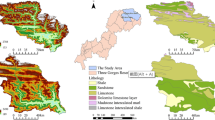Abstract
In this study, we address the characteristics of the spatial and temporal evolution of soil erosion in karstic mountainous area of Houzhai River Basin of southwest China. The study uses GIS, erodibility test results, actual surveys of soil types, a revised universal soil loss equation for estimating soil erosion in 1973, 1990, 2002, and 2013, and an analysis of the spatial and temporal distribution of the evolution law of soil erosion for almost 40 years. Results show the following: (1) The soil erosion modulus of the Houzhai River Basin exhibits a decrease from 222.72 t km−2 year−1 in 1973 to 103.82 t km−2 year−1 in 2013. (2) The intensity level of soil erosion changes across space. The most active area is mainly concentrated in the upstream peak cluster depression. Areas with a slope of 8°–25° account for 40.81 % of the total erosion contribution rate, indicating that these are the main areas where erosion occurs. (3) The global and universal classification standard of soil erosion shows that the Houzhai River Basin areas above 65 % do not undergo micro-erosion. The rocky desertification is a serious problem, which explains why grading standard soil erosion intensity is inapplicable to karst areas. (4) The average soil erosion modulus in the basin is generally low (i.e., below 1000 t km−2 year−1), which indicates strong karstification in the karst areas. This process can occur through subsurface pores, fissures, holes, and underground leakage phenomena, which underestimate the amount of soil erosion in the karst areas. A comprehensive analysis of a long time series reveals that soil erosion in the karst areas is a complex process which requires further detailed studies.
Similar content being viewed by others
References
Angulo-Martinez A.P.: Barros measurement uncertainty in rainfall kinetic energy and intensity relationships for soil erosion studies: an evaluation using PARSIVEL disdrometers in the Southern Appalachian Mountains. Geomorphology 228, 28–40 (2015)
Ni J.: Carbon storage in Chinese terrestrial ecosystems: approaching a more accurate estimate. Clim. Change. 119, 905–917 (2013)
Chen H.S, Liu J.W, Wang K.L.: Spatial distribution of rock fragments on steep hillslopes in Karst region of northwest Guangxi, China. Catena. 84, 21–28 (2011)
Terranova O., Antronico L., Coscarelli R., Iaquinta P.: Soil erosion risk scenarios in the Mediterranean environment using RUSLE and GIS: an application model for Calabria (southern Italy). Geomorphology 112, 228–245 (2009)
Bai Z.G., Wang G.J.: Study on watershed erosion rate and its environmental effects in Guizhou Karst region. J. Soil Water Conserv. 4, 1–7 (1998)
Chen X.P: Research on characteristics of soil erosion in Karst Mountainous region environment. J. Soil Water Conserv. 3, 31–36 (1997)
Peng J., Yang M.D.: On the present soil erosion situation of Huajiang Karst Gorge in Guizhou Province. J. Mt. Sci-Engl. 19, 511–515 (2001)
Mei Z.M., Wang D.N., Xiong K.N., Lan A.J., Chen Y.H., Sun J.C., Yu J.Y.: A preliminary study on the technology of vegetation restoration on the land of different rocky desertification degree: a case study of the Huajiang demonstration area Guizhou. Carsologuca. Sin. 23, 253–258 (2004)
Long, M.Z.: Water soil conservation effect and soil erosion models during the ecosystem rehabilitation of Karst valleys—taking Huajiang demonstration area as an example. Guizhou. Norm. Univ. 6, 17–22 (2006)
Fu W.L., Zhang Z.W., Zhang H., Xia K.S., Xie D.T., Ni J.P.: Study on characteristics of soil erosion on Karst Hillslope. J. Soil Water Conserv. 21, 38–41 (2007)
Wang H.Y., Hou Y.Y., Wu X.Q., Cai Y.L.: Mineral magnetic characteristics of sediments from Shibanqiao Reservoir, Guanling County, Guizhou Province and their implications on soil erosion. Geogr. Res. 25, 865–875 (2006)
Wang, Y.: Simulation study on soil erosion in Karst area: a case study of Wujiang River Basin in Guizhou Province. Peking. Univ. 14, 1–6 (2011)
Renard, K.G.; Foster, G.R.; Wessides,G.A.; et al.: Predicting Soil Erosion by Water: A Guide to Conservation Planning with the Revised Universal Soil Loss Equation(RUSLE)[S]// United States Department of Agriculture(USDA). Agricultural Handbook: No. 703. USDA, Washington (1997)
Renard K.G., Freimund J.R.: Using monthly precipitation data to estimate the R-factor in the revised USLE. J. Hydrol. 157, 287–306 (1994)
Huang Y.H., Lu C.L., Zheng T.F., Fu Q., Xu J.J.: Study on Rainfall Erosivity Index in Southeastern Fujian. J. Soil Water Conserv. 6, 1–5 (1992)
Zhou F.J., Chen M.H., Liu F.X.: The rainfall erosivity index in Fujian Province. J. Soil Water Conserv. 9, 13–18 (1995)
Wang W.Z., Jiao J.Y., Hao X.P., Zhang X.K., Lu X.Q., Chen F.Y., Wu X.: Study on rainfall erosivity in China. J. Soil Water Conserv. 9, 5–18 (1995)
Williams, J.R.; Sharply, A.N.: EPIC-erosion/productivity impact calculator. Model documentation, technical bulletin number 1768[M]. USDA-ARS, Washington 8–9 (1990)
Liu, B.Y.; Nearing, M.A.; Risse, L.M.: Slope gradient effects on soil loss for steep slopes. Trans. ASABE 16, 1835–1840 (1994)
Cai C.F., Ding S.W., Shi Z.H., Huang L., Zhang G.Y.: Study of applying USLE and geographical information system IDRISI to predict soil erosion in small watershed. J. Soil Water Conserv. 14, 19–24 (2000)
Wang W.F: Investigation of land erosion model of Houzhaihe catchment in Puding, Guizhou and its application. Guizhou. Geol. 18, 99–106 (2001)
Zhang X.B., Bai X.Y., Wen A.B.: A preliminary investigation of the potential for using the 137Cs technique to date sediment deposits in Karst depressions and to estimate rates of soil loss from karst catchments in Southwest China. Int. Assoc. Hydrol. Sci. (IAHS) 337, 149–156 (2010)
Bai X.Y.: Assessment of sediment and erosion rates by using the caesium-137 technique in a Chinese polygonal karst depression. Environ. Earth Sci. 64, 2151–2158 (2011)
Wang S.J., Ji H.B., OuYang Z.Y., Zhou D.Q., Zhang L.P., Li T.Y.: A preliminary study on the effect of soil carbonate rock weathering. SCI. China Ser. D 29, 441–449 (1999)
Author information
Authors and Affiliations
Corresponding author
Rights and permissions
About this article
Cite this article
Li, Y., Bai, X., Zhou, Y. et al. Spatial–Temporal Evolution of Soil Erosion in a Typical Mountainous Karst Basin in SW China, Based on GIS and RUSLE. Arab J Sci Eng 41, 209–221 (2016). https://doi.org/10.1007/s13369-015-1742-6
Received:
Accepted:
Published:
Issue Date:
DOI: https://doi.org/10.1007/s13369-015-1742-6




